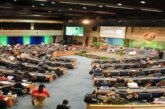Executive Summary
Please find the Executive Summary of the report “The Impacts of Sand and Dust Storms on Oceans” released virtually by UNEP on Friday the 6th of November. The report is written by Dr. Nicholas Middleton, Professor at Oxford University and worldwide renowned expert on Sand and Dust Storms and supported by GESAMP, the GPA, the GPNM, and the UN Decade of Oceans 2021-2030. We invite you to download the complete report from the UNEP website: https://www.unep.org/resources/report/impacts-sand-and-dust-storms-oceans

Sand and dust storms (SDS) are common in deserts and semi-deserts when strong winds blow over dry soils with little or no vegetation. Dust generated by SDS is often raised high into the atmosphere and transported over long distances, frequently over the oceans. These atmospheric events are important for ecosystem functioning, with a wide range of effects on the Earth system. Given the hazards they pose to society, and the threats implied to the achievement of several Sustainable Development Goals (SDGs), hey have also become an issue of increasing concern to governments and the international community.
SDS vary in frequency and intensity over multiple timescales. They are highly seasonal and can vary significantly from year to year. They also respond to drought periods and other drivers such as El Niño–Southern Oscillation and the North Atlantic Oscillation. Deserts in the northern hemisphere (northern Africa; the Middle East; southwest, central and north-east Asia) are the largest and most persistently active SDS sources, with smaller, less active sources located in North and South America, southern Africa, Australia and Iceland. The relative importance of naturally emitting wind erosion sources, as compared with those significantly influenced by human action— largely via
poor agricultural management and excessive water use—is unclear, but the Sahara is the world’s largest source of desert dust. It produces around 55 percent of all global dust emissions, with marked effects on the North Atlantic Ocean, the Caribbean Sea, the Mediterranean Sea and the Red Sea.
Each year, SDS carry an estimated average of half a billion tonnes of minerals and utrients, organic and inorganic matter to the oceans. This desert dust has a range of effects on marine biodiversity. Dust provides a major source of externally supplied nutrients and trace metals. These elements are essential for all life forms and their atmospheric supply can exert control over ocean primary production via single-celled organisms collectively known as phytoplankton. This key metabolic process drives biogeochemical cycles in the oceans, including the carbon, nitrogen, sulphur, phosphorus and silicon cycles.
The fertilizing effect of desert dust is also thought to have an impact on algal blooms, which are an important food source for marine life, although some—dubbed harmful algal blooms (HABs)—may have detrimental effects on human health and economic activity. Dust deposition may also play a role in the unusually large blooms of floating Sargassum seaweed mats that have been noted since 2011 in the Caribbean Sea and
the Atlantic Ocean along the coastlines of western Africa and Brazil. The cause of these blooms is a matter for debate, but nutrients in desert dust may enhance the growth of Sargassum.
Links have been found between desert dust and coral reef systems. The health of such reefs responds to numerous, frequently interlinked issues, but disease has been important in recent worldwide coral reef declines, and a number of diseases that affect coral are associated with microorganisms carried in desert dust. Dust deposition may be one of a range of influences that stress coral reefs, reducing their resilience to other factors that can cause their health to deteriorate.
Dust has significant impacts on weather and climate in several ways. One impact probably occurs indirectly via dimethyl sulphide (DMS) released from phytoplankton fertilized by iron-rich desert dust, which creates local climate feedbacks via additional cloud condensation nuclei. Dust also exerts indirect impacts on the climate system due to the part it plays in the global carbon cycle—a role stemming from further interactions between desert dust and the microorganisms responsible for primary production. The ‘biological carbon pump’ results in carbon being sequestered into the oceans from the atmosphere, with consequent feedback effects on climate. This occurs through carbon dioxide and nutrients being transformed into organic carbon, which sinks to the deep ocean, decomposes and becomes buried in sediment. The Southern Ocean, where primary productivity is limited by iron deficiency, could be particularly important in the operation of the biological carbon pump.
There are still considerable uncertainties around how SDS interact with the oceans and consequences for other parameters of the Earth system. This report highlights critical areas for further monitoring and study and where research can inform appropriate policy development. Understanding SDS and the longrange transport of desert dust to oceans is relevant to the three Rio conventions: the Convention on Biological Diversity (CBD), the United Nations Framework Convention on Climate Change (UNFCCC), and the United Nations Convention to Combat Desertification (UNCCD).
It also has significant implications for a number of SDGs, particularly SDG 14 on Life Below Water and SDG 15 on Life on Land, and demonstrates the interdependencies between the SDGs. This report’s publication is timely, coming at the beginning of the United Nations Decade of Ocean Science for Sustainable Development (2021– 2030), as well as the United Nations Decade on Ecosystem Restoration (2021–2030).



